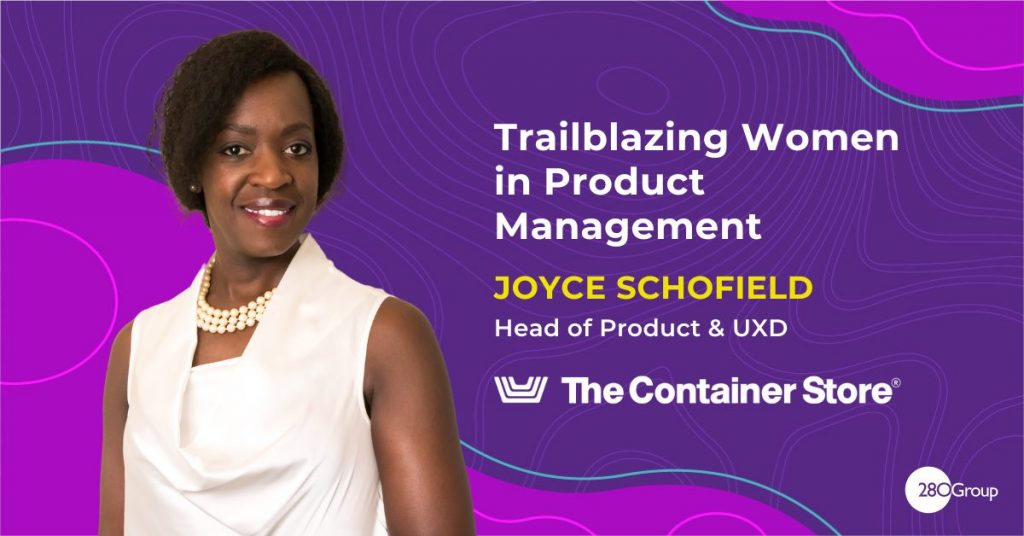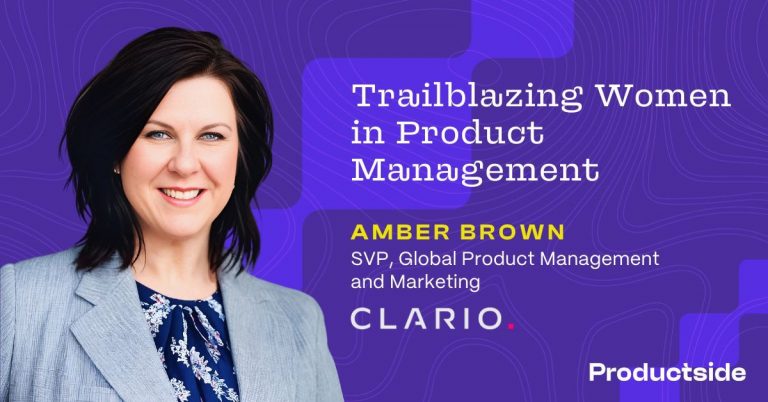
For our next installment of our Women in Product Management Series, I interviewed Joyce Schofield, Head of Product & UXD at The Container Store.
I believe the role of Product Manager is not understood and is underleveraged. I strongly believe that Product Management can be leveraged across any company to create that discipline of how to unlock potential and impact.
Nicole: Joyce, it’s a pleasure to meet you. Thank you for sharing your stories and inspiration.
Joyce: It’s my pleasure.
I love starting with my favorite question and that is what led you to Product Management?
It was serendipitous. I discovered this role called Product Manager, while I was a Sr., Auditor at Sprint in the 2000’s. I was recruited out of IT and brought in to help build the IT audit discipline and team, framework to support SOX audit, and later evolved to a team that supported a process improvement initiatives. During that time, I partnered with a VP who was leading our portfolio management process, responsible for the prioritization process and deciding which new products to invest in. Typically, these were large initiatives, 6 to 18 months, involving significant, multi-year investment. During this initiative, I learned about this team that prioritizes projects and I was fascinated—how did they get to decide what we spend money on? After I conducted the portfolio analysis, I left the VP with improvement recommendations. He was impressed with me, and I was impressed with his team. Out of the blue, I got a phone call from him. He said, “I have a job for you, and you need to take it.” And that was that. I’ve been in Product since 2006.
How fun to get that phone call! I bet that made you feel great.
He was a great mentor and leader. He put me in the right product area, on the right team, with the right manager. He knew my strengths from working with me previously on the portfolio planning and prioritization exercises. Because of that, I thrived so I stayed with Product.
What a great opportunity you were able to take advantage of. Were there any lessons that you learned through that process?
I have two pairs of lessons learned. The first pair is resiliency and stamina. You really need stamina to do Product Management. Sometimes the problem is not clear. You’ll think you’ve uncovered the problem, but then you realize you’re not solving it because you don’t have the problem nailed down and you have to go back to the drawing board. Sometimes you have to sell the product vision over and over again. One time it took me two years to sell this platform idea within my company. It took stamina to stay excited, positive, and optimistic. Even if you have a good idea and think you’re solving a problem, you’ve got to have resiliency and stamina to play the long game.
Another lesson pair is to be patient and give second chances. Being patient is important, especially from a leadership perspective. Leaders have to recognize when the intent is good, but the result isn’t what we’re looking for. I’ve got to give the team a second chance, a third chance, a fourth chance. If I believe it’s the right problem to solve, then I’ve got to have grace to say, let’s fail fast, learn and try again. That requires a lot of patience, on both sides. My team and I are expected to execute. We need results, but we need patience to deliver the right results.
If I believe it’s the right problem to solve, then I’ve got to have grace to say, let’s fail fast, learn and try again.
As you’ve learned these lessons, what has stuck out to you as the most challenging aspect of Product Management?
Surprisingly, in 2023, I feel that Product Management is still not well understood. Big tech companies understand the value of Product Managers for sure. But that’s not the only place where Product happens. Outside of tech companies, I believe the role of Product Manager is not understood and is underleveraged. I strongly believe that Product Management can be leveraged across any company to create that discipline of how to unlock potential and impact. Yet when I need to meet with somebody who doesn’t understand why, they ask, “What do you do again?” because they’ve never had a product team. I get questions like, “What is the difference between what you do and what Technology does? We used to go to the IT guy and tell him to build this thing for us.” People wonder how Product Management adds value. I explain that we try to make sure that we build the right thing, right, the first time. We do all the heavy lifting and the hard work to nail down the problem and what success looks like.
Another challenge in this fast-paced world is that things change so quickly. There is little to no patience for deep, intentional work, the kind of work that good Product Managers need to do. This deep work is how you figure out the right problem to solve. You’re doing the research. You’re talking to people. You’re testing things out. You’re prototyping. Sometimes it takes a while to nail it. The challenge is to keep up with the expectations of this fast-paced world while ensuring that the value of Product Management – the potential impact Product Managers can unleash within a company – is known. It takes space and time for that deep thinking. It takes research, analysis, and evangelization. It takes rounds of feedback before we actually nail it down. We must create that discipline of really good Product Management.
You have to do a lot of defining and defending of Product Management. With executive-level sponsorship of the Product team, I’m sure that makes your job easier. What else do you like about Product Management?
I’m a DIY person so I tinker a lot. As a natural problem solver, I don’t get stressed when something is not working. I like to figure it out. I love a good challenge, so I find myself in spaces with very complex product problems to solve, a place where none of my product peers want to go. This is why I’ve been doing this for so long.
I also love collaboration. I gravitate towards those teams with involvement in multiple areas of the business, rather than working in silos. I’m amazed how you can unlock brilliancy when you create the space, put the right people in the room, go in and ask, “How are we going to solve this?” and then just watch them. I know I don’t have all the answers, but when I collaborate with smart people, we figure it out. I love enabling that, which is why lately my passion has been developing and growing high-impact teams. I really believe that there is this energy, a special environment, that begins with trust. It entails doing really good, deep work, loving what you do, and loving who you’re doing it with. I love mentoring and growing people. We have a formal company-wide, 8-month mentorship program at The Container Store that connects people with mentors who are leaders in the company.
I’m amazed how you can unlock brilliancy when you create the space, put the right people in the room, go in and ask, “How are we going to solve this?” and then just watch them. I know I don’t have all the answers, but when I collaborate with smart people, we figure it out.
I love how you’re not only impacting everyone on your team, but others across the company as well. As you’re developing your Product Management team, what do you look for when you are hiring?
I’m looking for curious, open-minded, problem solvers. When I interview candidates, I take them through a narrative that helps me see how they think through problems. What is their mental model when they’re trying to figure things out? Something that can plague Product teams is analysis paralysis when they’re stuck talking and talking and not really doing anything. Product Managers need to default to action. When they default to action, how often do they make the right decisions? If they’re making wrong decisions a lot, then something is not connecting. It’s okay to make wrong decisions now and then but how often do they make the right decisions the first time?
Another thing I look for is empathy. Having customer empathy is putting yourself in the customer’s shoes to see what they’re going through and to understand how to create a great experience. Empathy is having a conversation to build that trust and collaboration.
But the most important thing for me is self-awareness. It’s the hardest to detect and the hardest to interview. Are you self-aware when you walk into a room? What do you notice? How do you project yourself? Are you self-aware when you have a lot to learn? Are you self-aware when you have a lot to give? I think self-awareness is a key part of being a Product Manager because Product Management is also product leadership. You don’t have to have a leadership title. If you’re making decisions on what something should be, you’re leading. Self-awareness is important for that leadership aspect of Product Management, so it’s important to me when I’m building my team.
You were originally brought into Product Management from another part of the company. That seems somewhat common. Is there any advice you have specifically for women looking to make the jump into Product Management?
The first thing I’d say is trust the research. Research shows that teams that have a good balance of women diversity make better decisions, make better leadership teams, and their companies seem to thrive. The second thing research shows is that women are inclined to have more empathy. It’s how we work and how we think. Even in different parts of the world, women are brought up to be nurturing and to have empathy. With that in mind, get connected to a network and find a good advocate. You might realize you’re one of the few women, especially in certain industries. You might be 100% of the representation of women in the room. In my case, I was often 100% of the representation of women, of blacks, and of foreigners in the room. That’s why it’s important to build your voice. The team is not diverse if your voice isn’t heard. Once you have a seat at the table, create a strong voice and advocate in a very respectful way that creates an environment where everybody wants to work with you.
How much more important is your one voice when your one voice represents 100% of a minority. Don’t be afraid to use your voice. My last question for you: do you have a motto or guiding principle that you live by?
What has stuck with me over the years is to build for the long term. It can be difficult because who knows what the future holds? But the products we create are not meant to be static. They’re meant to be organic, to grow and evolve. Most importantly, they’re meant to be a catalyst for change in the future. You don’t want to build a product that’s going to hold you back. Having the mindset of building for the long term gives us that urgency to break the problem up and build the right product now, while still thinking about what that product can become in the future. So essentially the principle is, make the right decisions now to build for the long term.
Having the mindset of building for the long term gives us that urgency to break the problem up and build the right product now, while still thinking about what that product can become in the future.
I like the idea of being a catalyst for change. Your products are meant to make an impact. Thank you so much, Joyce. I loved hearing your story.
Thank you so much for the opportunity to share my thoughts and perspectives.
To read the entire series on Women in Product Management make sure to sign up for our newsletter.


